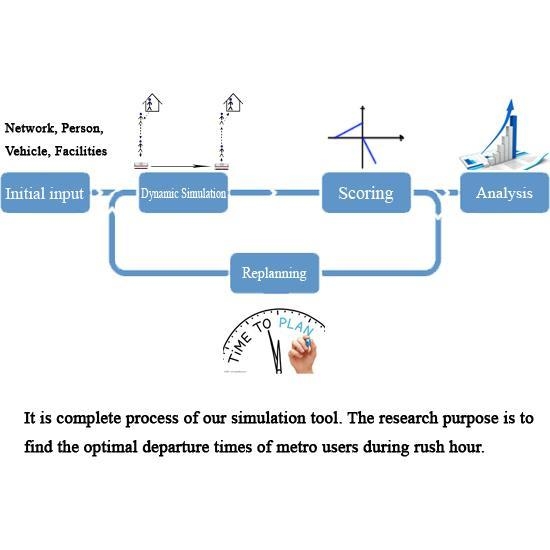The Dynamic Optimization of the Departure Times of Metro Users during Rush Hour in an Agent-Based Simulation: A Case Study in Shenzhen, China
Abstract
:1. Introduction
2. Methodology
2.1. Overview of MATSim
2.2. Overview of the New Simulation System CCTSim
2.2.1. Initial Input
2.2.2. Dynamic Simulation
2.2.3. Scoring
- The going to work travel plan is computed as the travel utility plus the arrival utility :where is the empirical travel time; is the real travel time; is the arrival time; and is the obligatory arrival time, which is set to 9:00 a.m. are three parameters, for which the default values are 4, 5/3 and −12 in the simulations described here.
- Because there is no obligatory arrival time when getting off work, the getting-off-work travel plan is computed as the travel utility :where the variables have the same meanings as in Equation (1), above.
2.2.4. Replanning
- (1)
- Adjusting the departure time for going to workThe objective of replanning when to leave for work is to identify a relatively optimal departure time such that the travel time of a person agent is as short as possible, and the person agent arrives as close as possible to the obligatory arrival time, without being late.
- (2)
- Adjusting the departure time for getting off workThe objective of replanning when to leave from work is simply to make the travel times of the person agents as short as possible.
2.2.5. Analysis
3. Scenario
3.1. The Study Area and Its Metro Network
3.2. The Travel Plans of Person Agents
3.3. The Simulation and Replanning Process
- ①
- In the first iteration, in order to avoid congestion, the metro capacity is set to an infinite number. Thus, all of the person agents can execute their initial travel plan without congestion. The simulation tool counts person agents as being late if their real travel time is longer than the corresponding empirical time and notes how late they arrive. Subsequently, the initial departure times of these person agents are adjusted forward so that they will not be late again using the same travel routes. The following formula is used to adjust the initial departure time:where is the amount of time by which a person agent is late, measured in minutes; is the hour of the arrival time; is the hour of the obligatory time; is the minutes of the arrival time; is the minutes of the obligatory time, is the seconds of the arrival time; is the new departure time in the next iteration; is the departure time in this iteration; is the departure time interval of the metro; and is the floor function.
- ②
- In the subsequent iterations, the metro capacity is set to a suitable value, and each person agent faces the possibility of being late due to missing a metro trip. Note that the passage flow simulation in our simulation tool is implemented as a queue simulation, in which each metro stop is represented as a first-in first-out queue. Thus, person agents who were late in the last iteration can beat other competitors and board a given metro train by setting out just a few minutes, even one minute, early. The following formula gives the departure time adjustment:where the is the departure time in iteration (x + 1), is the departure time in iteration x and is the step length (minutes) of the departure time adjustment for person agents who were late when going to work or missed metro trips when getting off work in the previous iteration. Specifically, has a negative value for the forward adjustment of the departure time when going to work and a positive value for the backward adjustment of the departure time when getting off work.
- ③
- As this iterative adjustment is performed, the departure time becomes increasingly early for those who are late, and the congestion is progressively reduced. The iterative process is stopped when none of the person actors are late. At that point, all of the metro trains that previously experienced congestion are full when leaving their stops.
4. Results and Discussion
4.1. The Number of Person Agents Who Are Late and the Occurrence of Congestion at Metro Stops
4.2. Average Travel Score
4.3. Average Departure Time and Travel Time
4.4. Verification of Our Simulation Results
5. Conclusions
- The method presented here represents a research method that is appropriate for the study of urban resident trips using multi-agent technology. This method illustrates the flow of people in any transportation facility at any time and can overcome the flaws of traditional mathematical and statistical models, such as difficulties in describing complex traffic and trip environments.
- A strategy for performing dynamic optimization of the departure times of metro users has been proposed to solve the two problems mentioned at the end of the Introduction. With this strategy, the average travel time becomes shorter, and there is no premature arrival when going to work and no late departure when getting off work. These results can provide the public with suggestions regarding their travel plans and allow commuters more time to do other things, such as sleeping, eating breakfast and shopping.
- Furthermore, the severe congestion at some metro stops leads to long wait times during rush hour. Thus, the existing metro resources are still having difficulties in meeting the actual travel demand. These findings can provide suggestions to public transport management departments, such as to shorten the departure intervals and accelerate the speeds of train operation. The different parameter values of departure intervals and train speeds must be tested in our simulation tool to find better results.
- There are several aspects of the problem that should be investigated in future research. First, large-scale simulations of other modes of travel, such as car or bus travel, should be tested in our simulation tools to better optimize commuters’ departure times and travel routes. Second, the optimal departure interval for each metro line during rush hour should be found to assist in transport planning. It will increase the transportation capacity of metro system without wasting transportation resources. Finally, the person agents’ travel strategies could be modified by introducing game theory to attempt to explore the Nash equilibrium of commuters’ travel strategies. It will be the best travel strategies for any commuter in theory when taking metro during rush hour.
Acknowledgments
Author Contributions
Conflicts of Interest
References
- Sun, J.W. Study on Agent-Based Intelligent Traffic Control Strategy and Visual Dynamic Simulation; China Agricultural University: Beijing, China, 2001. [Google Scholar]
- Gao, J. Space-Time Coordinating Optimization Theory and Method of Urban Multilevel Transit Network Based on the Travel Behavior of Residents; Beijing Jiao Tong University: Beijing, China, 2013. [Google Scholar]
- Enock, T.; Ren, M.; Eren, E.O. An Alternative Approach to Network Demand Estimation: Implementation and Application in Multi-Agent Transport Simulation (MATSim). Procedia Comput. Sci. 2014, 37, 382–389. [Google Scholar]
- Shanghai Municipal Engineering Administration Department, Tongji University. Study on Shanghai Expressway Transportation Management System; Shanghai Municipal Engineering Administration Department: Shanghai, China, 2000.
- Papageorgiou, M.; Blosseville, J.M.; Haj-Salem, H. Modelling and Real-Time Control of Traffic Flow on the Southern Part of Boulevard Peripherique in Paris: Part I: Modelling. Transp. Res. Part A 1990, 24, 345–359. [Google Scholar] [CrossRef]
- Wang, Y.L. Agent-Based Design and Implementation of Microscopic Traffic Simulation System; University of Electronic Science and Technology of China: Chengdu, China, 2012. [Google Scholar]
- Lighthill, M.J.; Whitham, G.B. A Theory of Traffic Flow on Long Crowded Roads. Proc. R. Soc. Lond. 1955, 1178, 317–345. [Google Scholar] [CrossRef]
- Richards, P.I. Shock Waves on the Highway. Oper. Res. 1956, 4, 42–51. [Google Scholar] [CrossRef]
- Reuschel, A. Vehicle Movements in a Platoon with Uniform Acceleration or Deceleration of Lead Vehicle. Z. Oesterreichisch. Ing. Archit. Ver. 2003, 95, 50–62. [Google Scholar]
- Pipes, L.A. An Operational Analysis of Traffic Dynamics. J. Appl. Phys. 1953, 4, 274–281. [Google Scholar] [CrossRef]
- Gipps, P.G. A Model for the Structure of Lane Changing Decisions. Transp. Res. B 1986, 20, 403–414. [Google Scholar] [CrossRef]
- Prigogine, I.; Andrews, F.C. A Boltzmann Like Approach for Traffic flow. Oper. Res. 2003, 8, 789–797. [Google Scholar] [CrossRef]
- Karina, R.; Carelia, G.; Manuel, C. Agent-Based Model for Automaticity Management of Traffic Flows across the Network. Appl. Sci. 2017, 7, 928–945. [Google Scholar]
- Mitchell, M. Complexity: A Guided Tour; Oxford University Press, Inc.: New York, NY, USA, 2009. [Google Scholar]
- Toroczkai, Z. Complex networks the challenge of interaction topology. Los Alamos Sci. 2005, 29, 94–109. [Google Scholar]
- Lian, J. Intelligent Traffic Control System Based on Agent; Shandong University of Science and Technology: Qingdao, China, 2007. [Google Scholar]
- MATSim. Available online: http://www.matsim.org/ (accessed on 1 July 2017).
- Arentze, T.A.; Timmermans, H.J. A Learning-Based Transportation Oriented Simulation System. Transp. Res. Part B 2004, 38, 613–633. [Google Scholar] [CrossRef]
- Auld, J.A.; Mohammadian, A. Planning Constrained Destination Choice Modeling in the Adapts Activity-Based Model. In Proceedings of the Transportation Research Board 90th Annual Meeting, Washington, DC, USA, 23–27 January 2011. [Google Scholar]
- Feil, M.; Balmer, M.; Axhausen, K.W. New Approaches to Generating Comprehensive All-Day Activity-Travel Schedules. In Proceedings of the Transportation Research Board Annual Meeting, Washington, DC, USA, 10–14 January 2010. [Google Scholar]
- Horni, A.; Nagel, K.; Axhausen, K.W. The Multi-Agent Transport Simulation MATSim; Swiss Fed Inst Tech—Zurich Switzerland: Zurich, Switzerland, 2016. [Google Scholar]
- Balmer, M.; Raney, B.; Nagel, K. Adjustment of Activity Timing and Duration in an Agent-Based Traffic Flow Simulation. In Progress in Activity-Based Analysis; Elsevier: Amsterdam, The Netherlands, 2005; pp. 91–114. [Google Scholar]
- Raney, B.; Cetin, N.; Völlmy, A.; Vrtic, M.; Axhausen, K.; Nagel, K. An Agent-Based Microsimulation Model of Swiss Travel: First Results. Netw. Spat. Econ. 2003, 3, 23–41. [Google Scholar] [CrossRef]
- Cetin, N.; Burri, A.; Nagel, K. A Large-Scale Agent-Based Traffic Microsimulation Based on Queue Model. In Proceedings of the Swiss Transport Research Conference (STRC), Monte Verita, Switzerland, 19–21 March 2003. [Google Scholar]
- Kaddoura, I.; Kickhöfer, B.; Neumann, A.; Tirachini, A. Public Transport Supply Optimization in an Activity-Based Model: Impacts of Activity Scheduling Decisions and Dynamic Congestion. In Proceedings of the Latsis Symposium, Zurich, Switzerland, 11–14 September 2012; pp. 12–38. [Google Scholar]
- Huang, L.; Tang, X.L.; Lin, Y.L. Spatio-Temporal Analysis of Public Transport Passenger Flow Based on Public Transport Card Data—A Case Study of Shenzhen. China High-Tech Enterp. 2016, 17, 87–89. [Google Scholar]


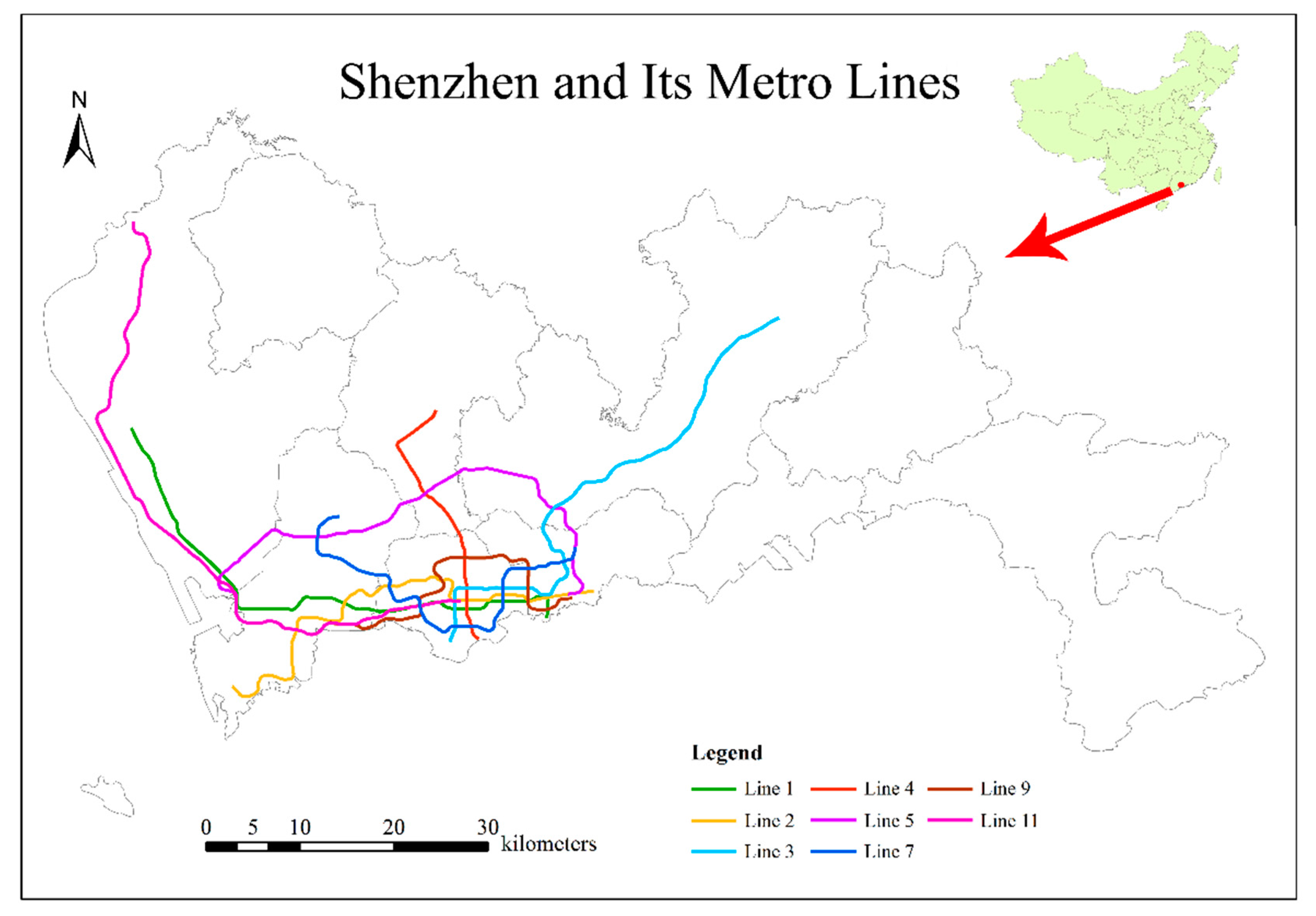
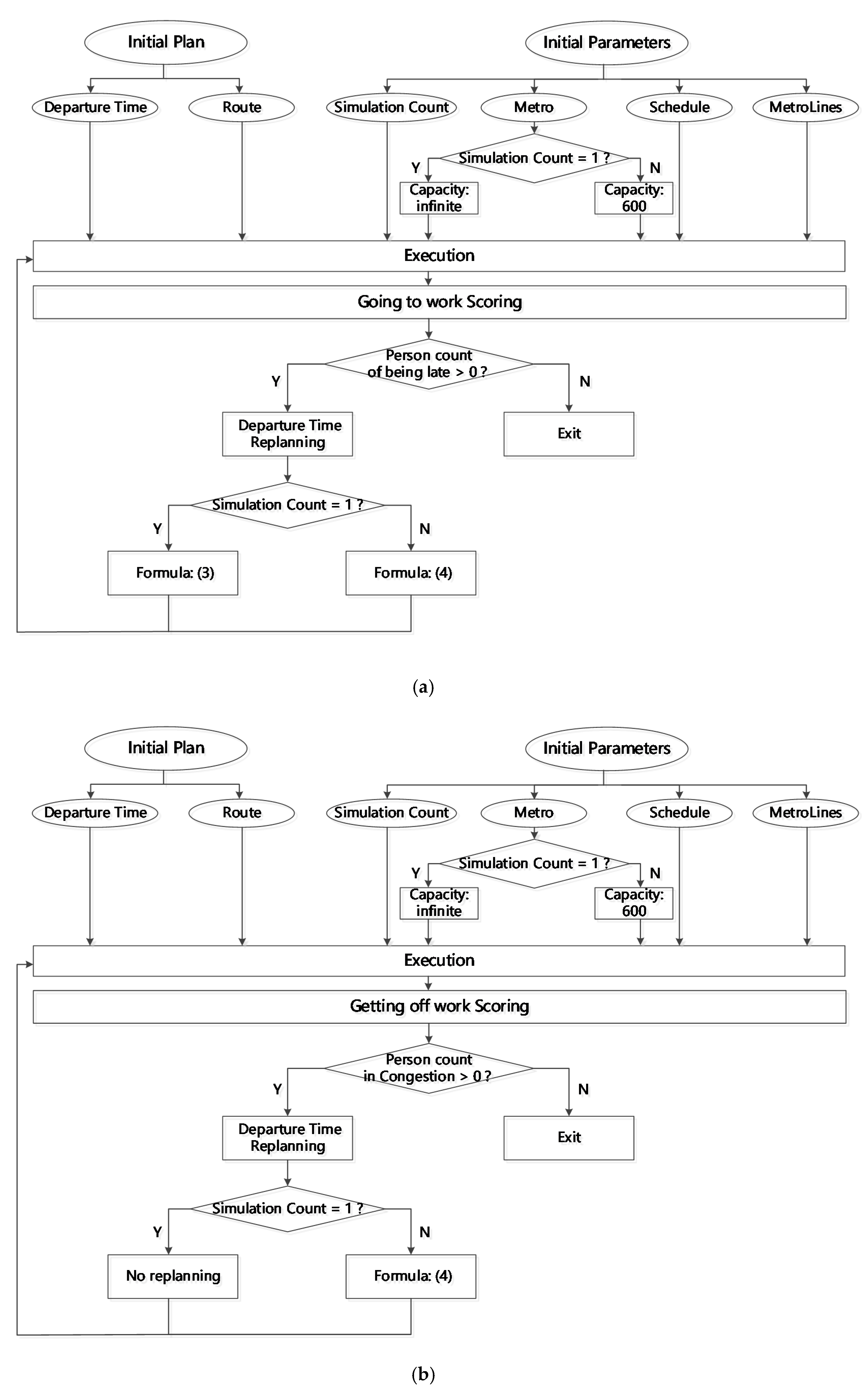
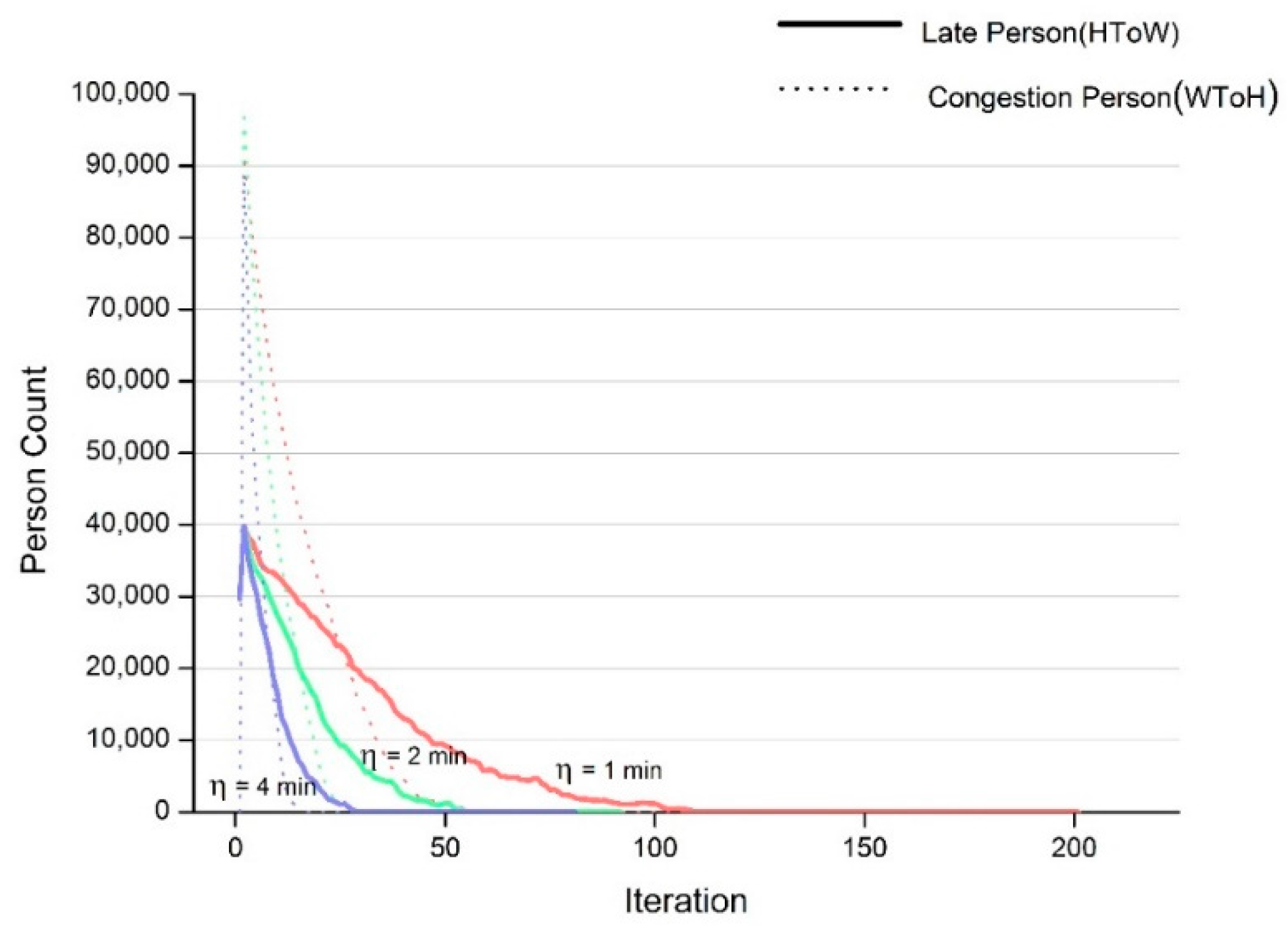
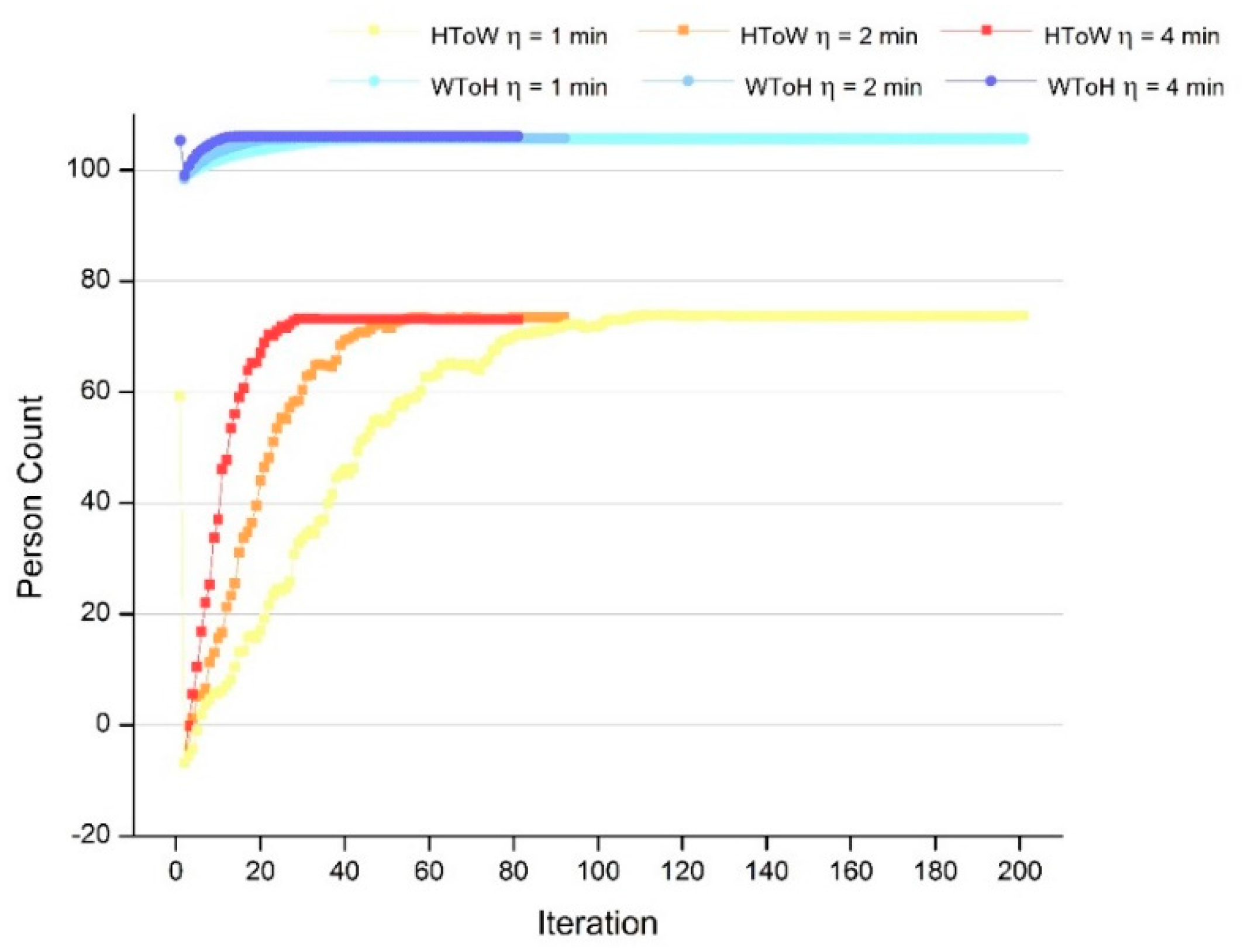
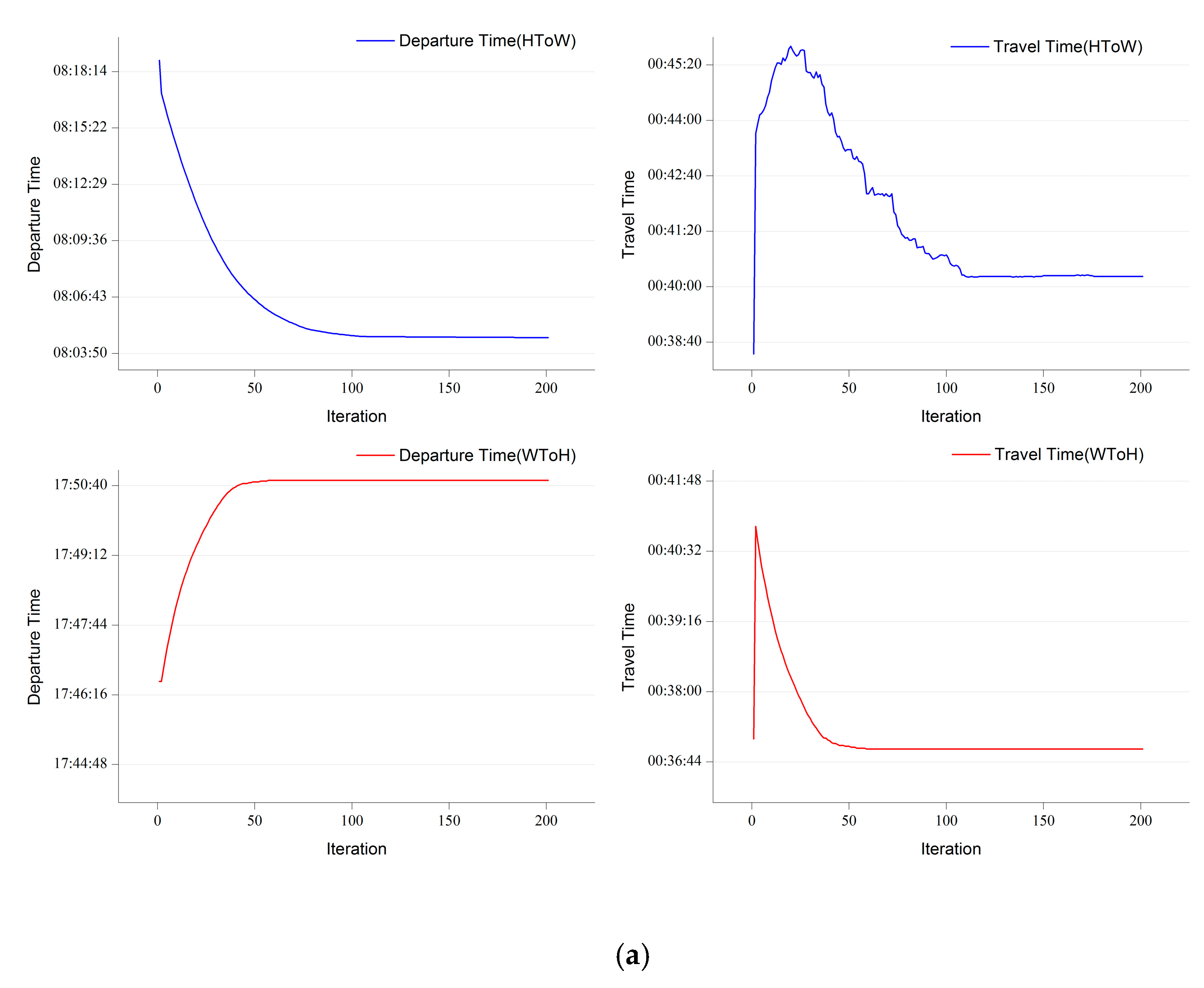
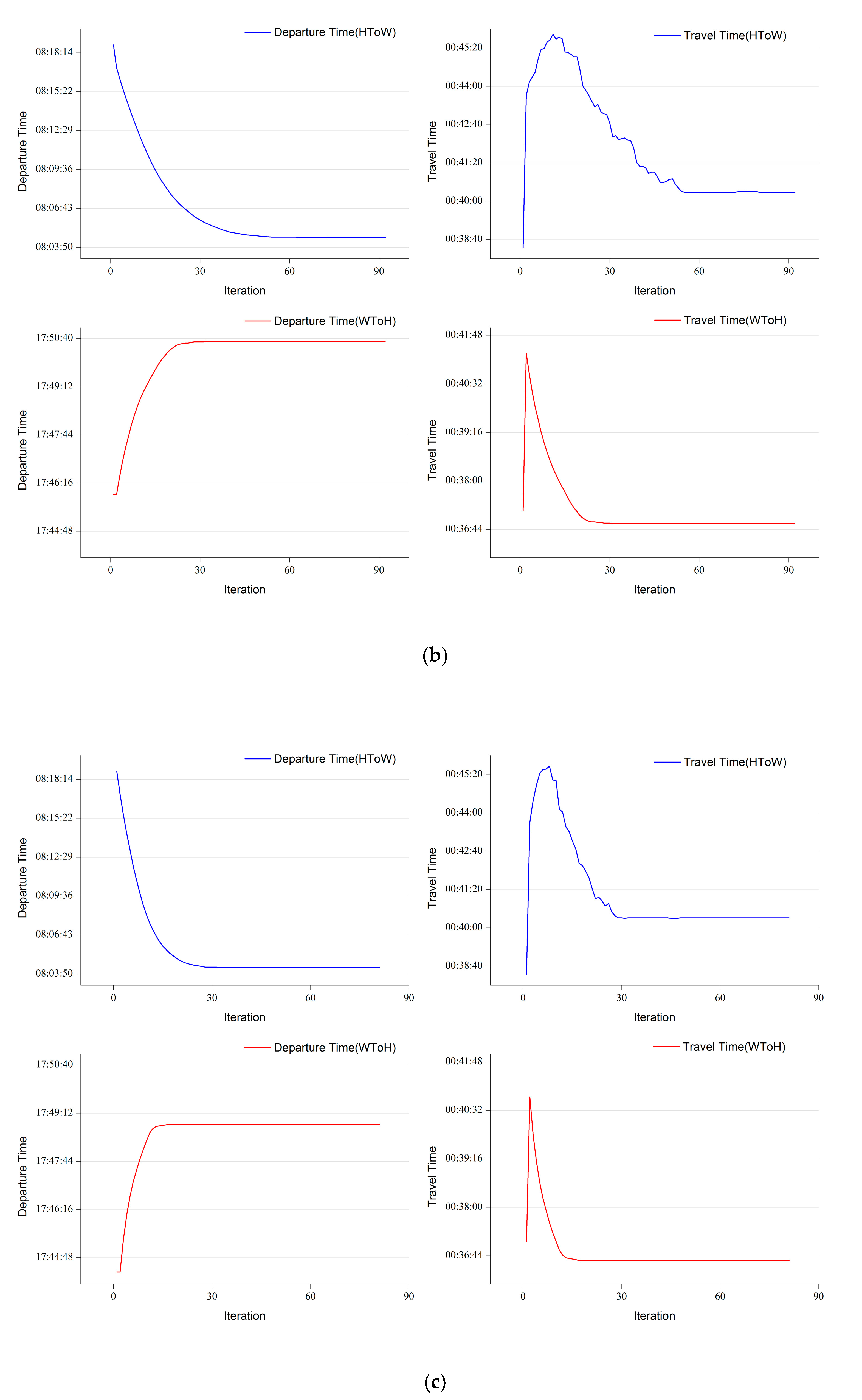
| ID | Empirical Travel Time | Trip Purpose | Travel Route |
|---|---|---|---|
| 1 | 24 min 8 s | Going to work | 1. Walk 604 m |
| 2. At the Nonglin station, take Line 7 to the Shangsha station | |||
| 3. Walk 545 m | |||
| 2 | 26 min 5 s | Going to work | 1. Walk 183 m |
| 2. At the Xiangmei North station, take Line 2 to the Jingtian station | |||
| 3. Walk 51 m and transfer to Line 2 | |||
| 4. At the Jingtian station, take Line 9 to the Chegongmiao station | |||
| 5. Walk 727 m | |||
| 3 | 17 min 8 s | Getting off work | 1. Walk 335 m |
| 2. At the Huaxin station, take Line 3 to the Children’s Palace station | |||
| 3. Walk 380 m | |||
| 4 | 1 h 25 min 28 s | Getting off work | 1. Walk 598 m |
| 2. At the Airport East station, take Line 1 to the Convention and Exhibition Centre station | |||
| 3. Transfer to Line 4 | |||
| 4. At the Convention and Exhibition Centre station, take Line 4 to the Futian Port station | |||
| 5. Walk 598 m |
| Capacity | Speed (m/s) | Number of Cars | Number of Doors | Service Time | Departure Interval |
|---|---|---|---|---|---|
| 3000 | 12 | 6 | 30 | 6:00–23:00 | 5 min |
| Capacity | Speed (m/s) | Number of Cars | Number of Doors | Service Time | Departure Interval |
|---|---|---|---|---|---|
| 600 | 12 | 2 | 10 | 6:00–23:00 | 5 min |
| Item | Average Departure Time | Average Arrival Time | Average Time of Boarding at the Origin Metro Stop | Average Time of Departure from the Destination Metro Stop | Average Travel Time (Without Walking Time) |
|---|---|---|---|---|---|
| Simulation | 8:04:31 | 8:44:51 | 8:07:48 | 8:41:57 | 34 min 09 s |
| Reality | - | - | 8:13:01 | 8:39:46 | 36 min 45 s |
| Difference | - | - | −5 min 13 s | 2 min 11 s | −2 min 36 s |
| Item | Average Departure Time | Average Arrival Time | Average Time of Boarding at the Origin Metro Stop | Average Time of Departure from the Destination Metro Stop | Average Travel Time (Without Walking Time) |
|---|---|---|---|---|---|
| Simulation | 17:50:05 | 18:26:54 | 17:52:59 | 18:23:37 | 30 min 38 s |
| Reality | - | - | 18:21:46 | 18:56:12 | 34 min 26 s |
| Difference | - | - | −28 min 47 s | −32 min 35 s | −4 min12 s |
| Item | Average Walking Time (HToS) | Average Walking Time (SToW) | Average Total Walking Time |
|---|---|---|---|
| Simulation | 3 min 17 s | 2 min 54 s | 6 min 11 s |
© 2017 by the authors. Licensee MDPI, Basel, Switzerland. This article is an open access article distributed under the terms and conditions of the Creative Commons Attribution (CC BY) license (http://creativecommons.org/licenses/by/4.0/).
Share and Cite
Xi, Y.; Du, Q.; He, B.; Ren, F.; Zhang, Y.; Ye, X. The Dynamic Optimization of the Departure Times of Metro Users during Rush Hour in an Agent-Based Simulation: A Case Study in Shenzhen, China. Appl. Sci. 2017, 7, 1102. https://doi.org/10.3390/app7111102
Xi Y, Du Q, He B, Ren F, Zhang Y, Ye X. The Dynamic Optimization of the Departure Times of Metro Users during Rush Hour in an Agent-Based Simulation: A Case Study in Shenzhen, China. Applied Sciences. 2017; 7(11):1102. https://doi.org/10.3390/app7111102
Chicago/Turabian StyleXi, Yuliang, Qingyun Du, Biao He, Fu Ren, Yu Zhang, and Xinyue Ye. 2017. "The Dynamic Optimization of the Departure Times of Metro Users during Rush Hour in an Agent-Based Simulation: A Case Study in Shenzhen, China" Applied Sciences 7, no. 11: 1102. https://doi.org/10.3390/app7111102
APA StyleXi, Y., Du, Q., He, B., Ren, F., Zhang, Y., & Ye, X. (2017). The Dynamic Optimization of the Departure Times of Metro Users during Rush Hour in an Agent-Based Simulation: A Case Study in Shenzhen, China. Applied Sciences, 7(11), 1102. https://doi.org/10.3390/app7111102




